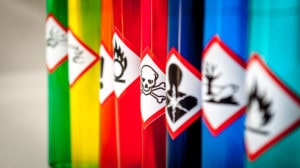The Chemicals in Your Workplace
Let’s start with the basics. No matter what kind of company you work for and what its primary business activities are, you most likely have chemicals in your workplace. They might be housekeeping chemicals like floor cleaners and paints, maintenance chemicals like oils and lubricants, or process chemicals like acids or solvents used to manufacture a chemical product. You might find these chemical products under the sink in the breakroom, in a drum in a chemical storage cabinet, or on a table right in the middle of a workstation.
Chemical products can be dangerous for a number of reasons. Often, they have physical hazards, which are basically hazards inherent in the properties of the chemicals themselves and possible consequences of use or storage. They might be flammable, like many common solvents such as acetone or isopropyl alcohol are, for instance, or explosive, like nitroglycerin. There are also types of chemicals that react strongly with certain other chemicals, including oxidizers like potassium permanganate, which can react strongly with chemicals such as glycerin – even to the point of producing flames! Another common physical hazard is compressed gas, commonly found as canisters of propane for fueling or tanks of welding and blanketing gases such as acetylene or argon.
 Other chemicals are health hazards, because exposure to them can result in acute or chronic health effects. They might be corrosive, like strong acids (hydrochloric acid, sulfuric acid) or strong bases (sodium hydroxide, potassium hydroxide), which can damage body tissue upon contact. Some chemicals such as arsenic are acutely toxic, meaning that a single dose or short exposure can result in serious health effects, or even death. Finally, different types of chemicals can cause a range of health symptoms from short-term or long-term exposure, including respiratory tract irritation, skin sensitization, narcotic effects, or irritation to the skin and eye. Finally, chemicals that are environmental hazards can adversely affect the health of organisms or humans if they enter aquatic environments, such as rivers and lakes.
Other chemicals are health hazards, because exposure to them can result in acute or chronic health effects. They might be corrosive, like strong acids (hydrochloric acid, sulfuric acid) or strong bases (sodium hydroxide, potassium hydroxide), which can damage body tissue upon contact. Some chemicals such as arsenic are acutely toxic, meaning that a single dose or short exposure can result in serious health effects, or even death. Finally, different types of chemicals can cause a range of health symptoms from short-term or long-term exposure, including respiratory tract irritation, skin sensitization, narcotic effects, or irritation to the skin and eye. Finally, chemicals that are environmental hazards can adversely affect the health of organisms or humans if they enter aquatic environments, such as rivers and lakes.
It’s important to realize that it’s not always obvious how to flag the dangerous chemicals in your workplace in the absence of detailed hazard information. For instance, you can get dangerous chemicals from many sources, not just from major chemical manufacturers or suppliers. For example, if you go to a hardware store, you can usually buy “muriatic acid,” which is the trade name for a product containing hydrochloric acid, which is an extremely corrosive acid capable of eating through plastics and metals – as well as your own skin and flesh!
Dangerous chemicals often also don’t look any different from any other chemicals. In fact, many highly toxic liquid chemicals are clear and therefore can look much like water, and can cause serious injury or death in the event of accidental ingestion. Many solid chemicals are white and granular in appearance, and can be mistaken for more innocuous materials like sugar.
This actually happened at a restaurant in a 2014 incident in which a restaurant employee added some of the caustic cleaning chemical lye to a batch of iced tea, because it looked like sweetener and had been in an unlabeled container. The customer who drank the iced tea containing the lye suffered severe burns to her esophagus and mouth as a result and very nearly died from her injuries.
The important point here is that you can’t protect yourself, or your employees from the effects of exposure to these chemicals unless you have accurate information about their hazards. You also can’t effectively plan your emergency response procedures in the event of a spill, explosion, fire, or other chemical accident. That’s why it’s so important to get HazCom right.







